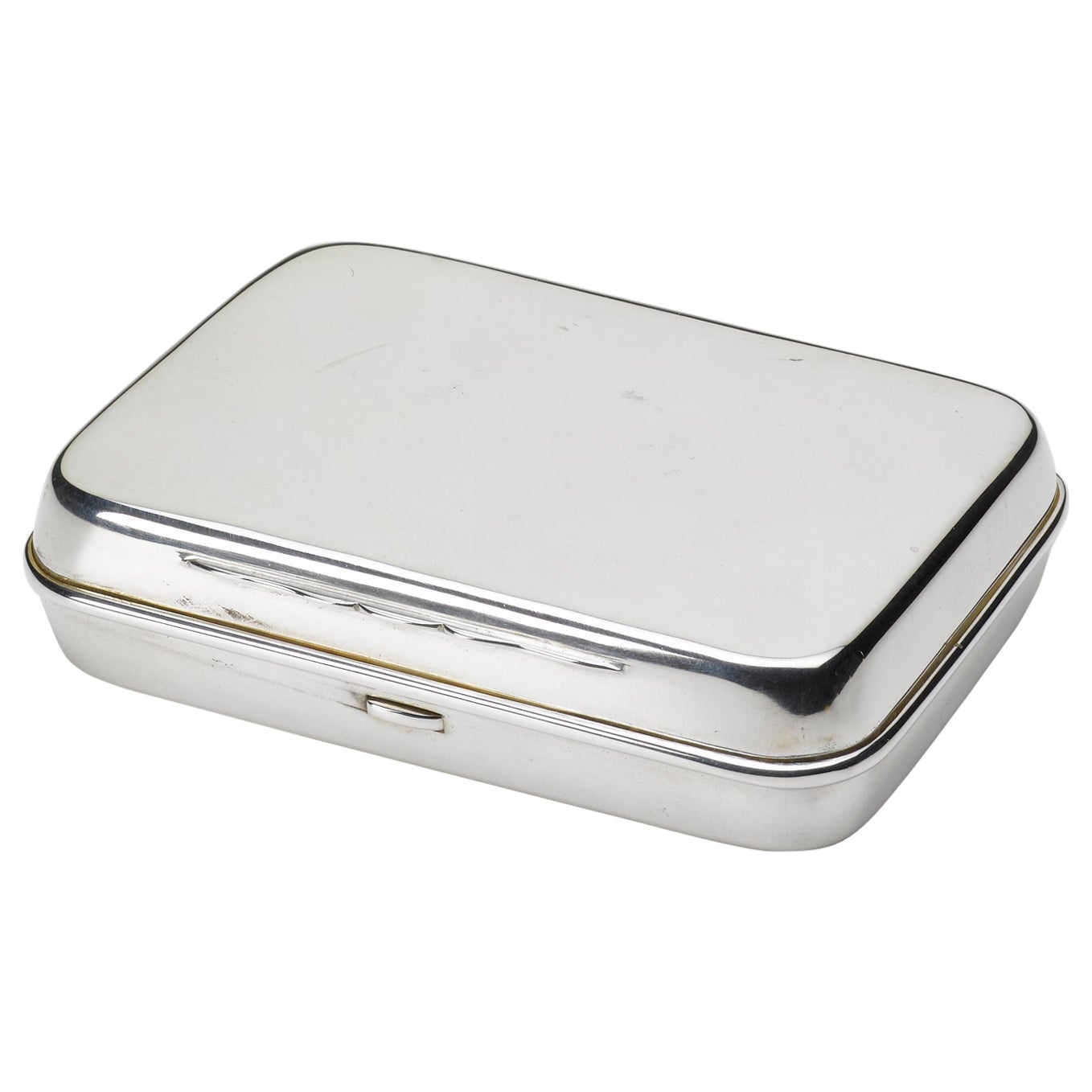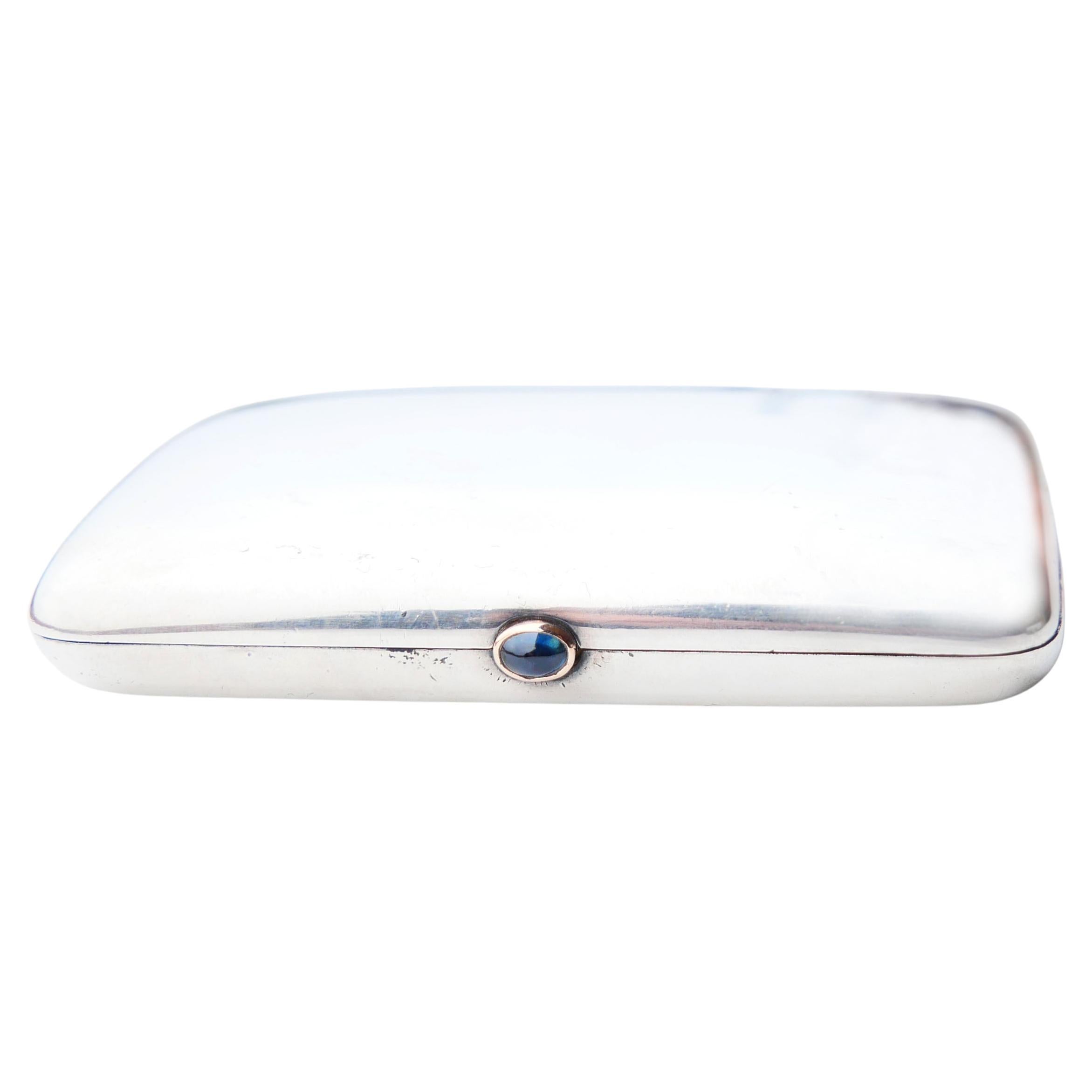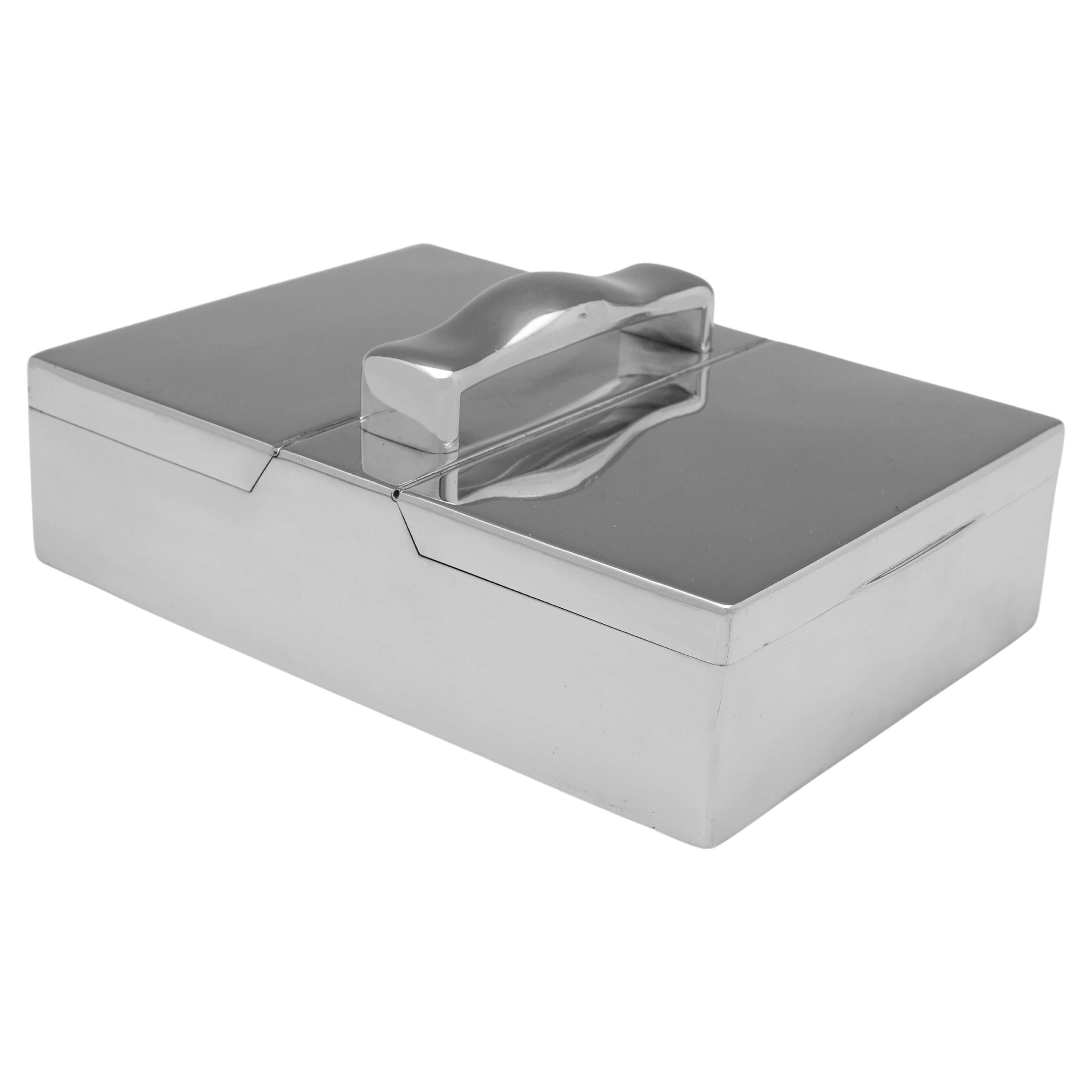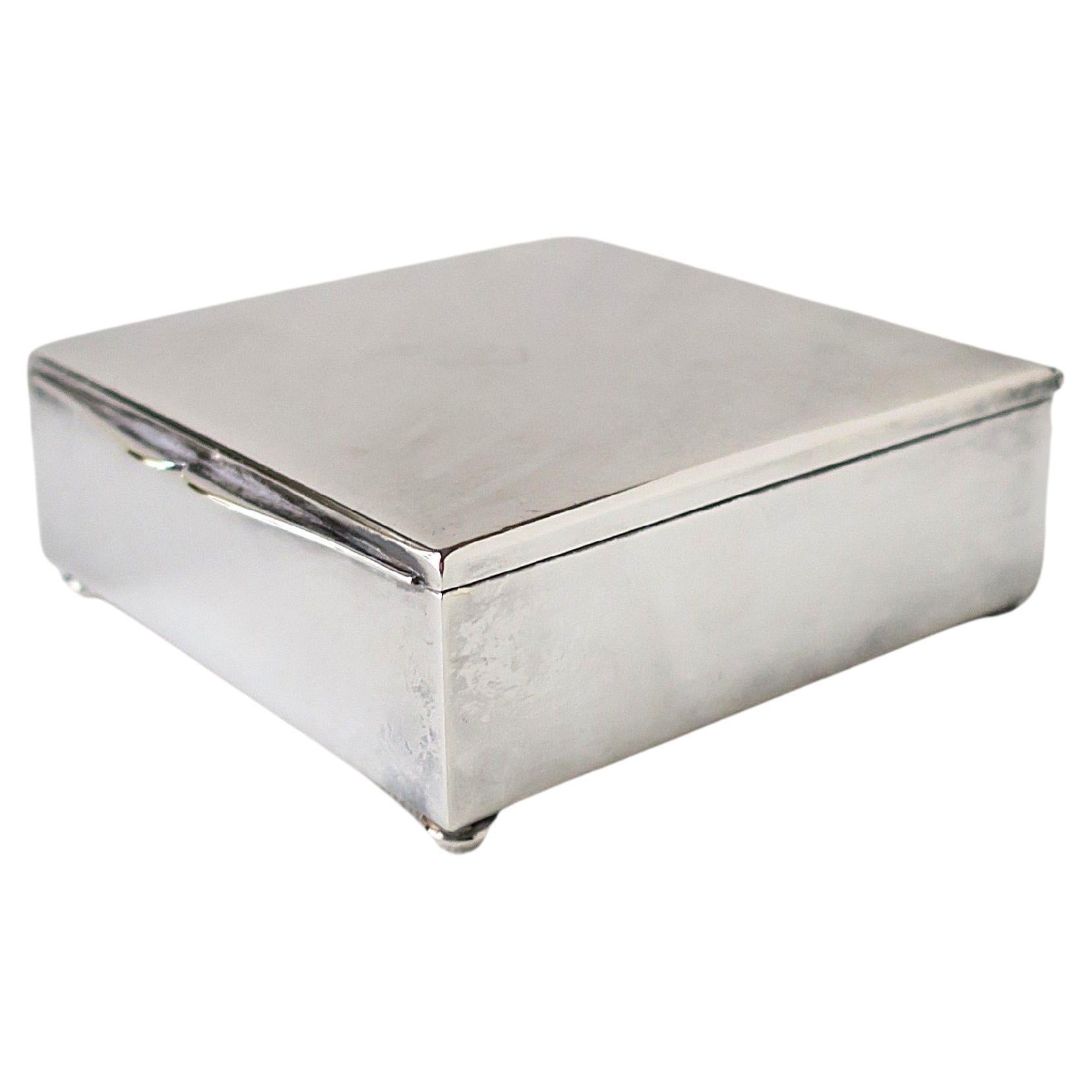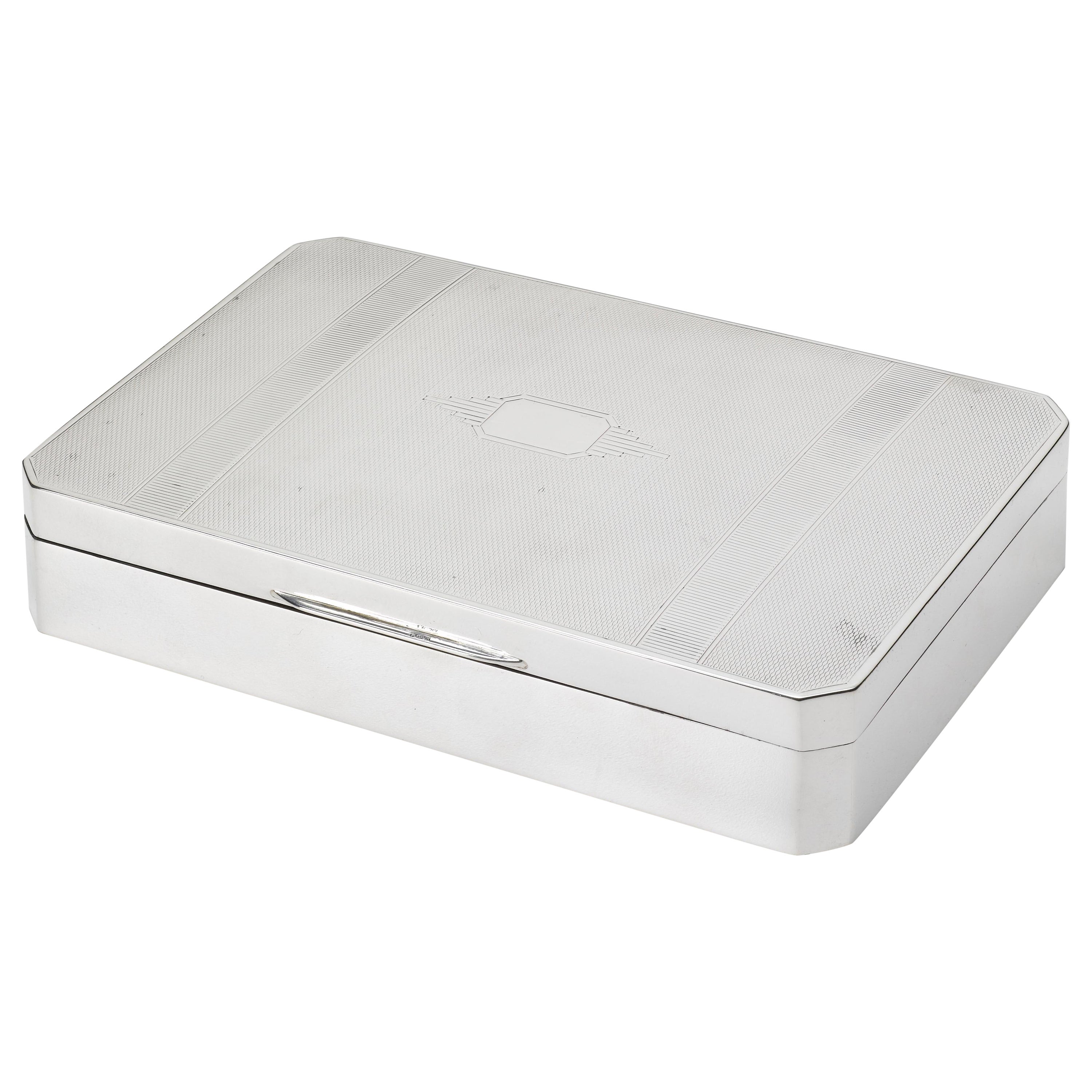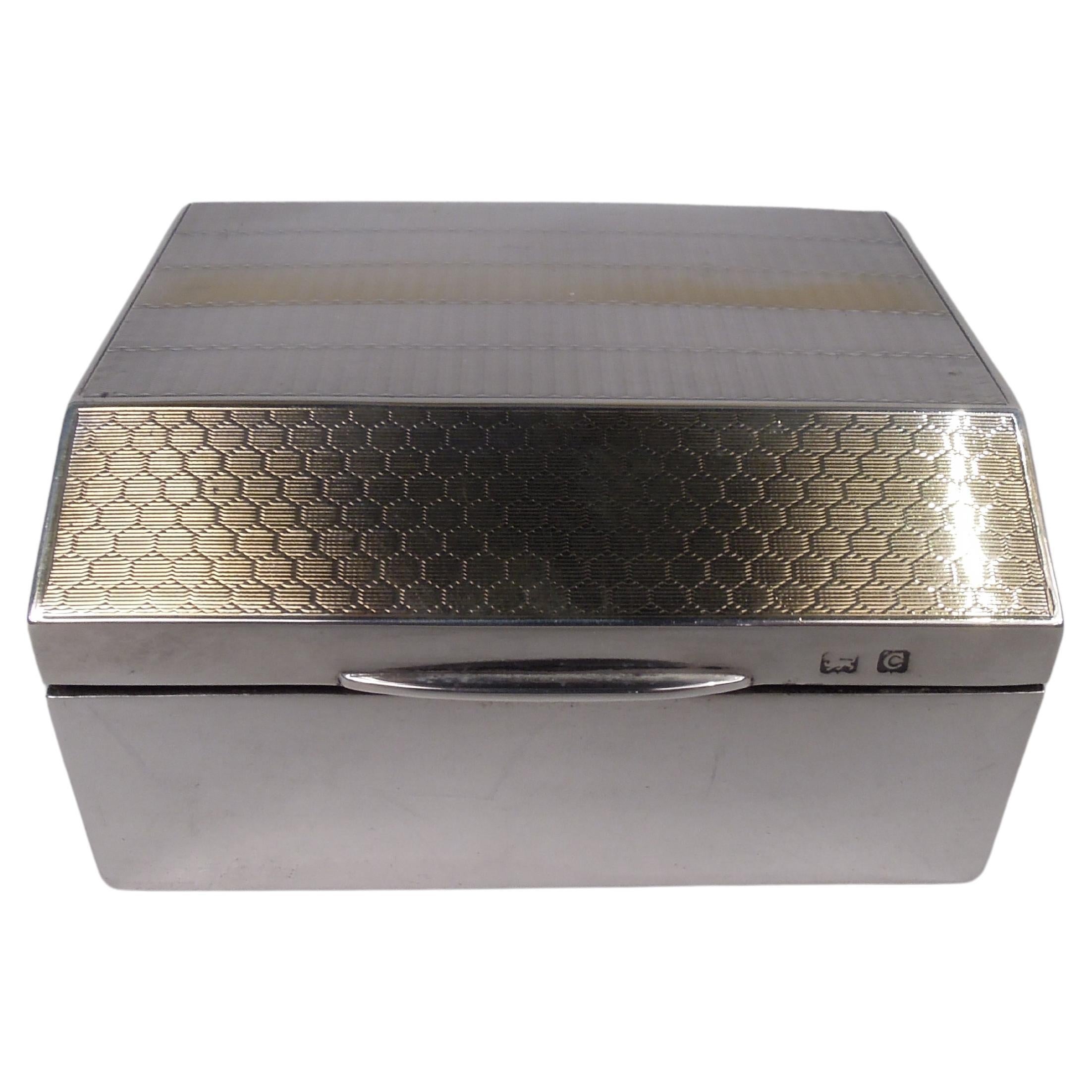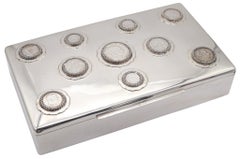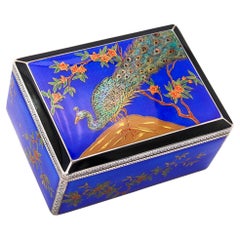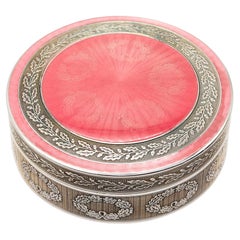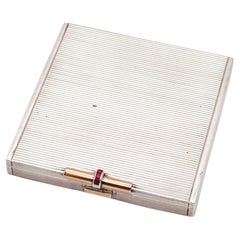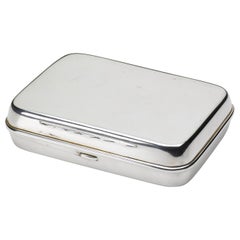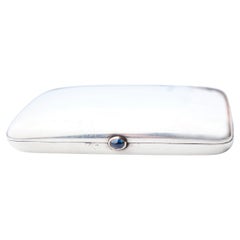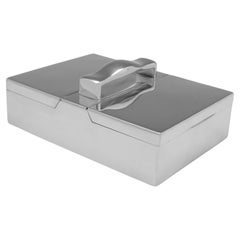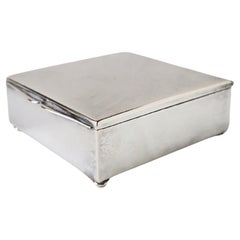Items Similar to Ernest Cambeau Paris 1920 Art Deco Box .950 Sterling Silver with Ceylon Sapphire
Want more images or videos?
Request additional images or videos from the seller
1 of 9
Ernest Cambeau Paris 1920 Art Deco Box .950 Sterling Silver with Ceylon Sapphire
$1,516
$1,89520% Off
£1,149.79
£1,437.2420% Off
€1,320.58
€1,650.7220% Off
CA$2,171.88
CA$2,714.8520% Off
A$2,391.08
A$2,988.8520% Off
CHF 1,222.09
CHF 1,527.6120% Off
MX$28,538.18
MX$35,672.7220% Off
NOK 15,559.76
NOK 19,449.7020% Off
SEK 14,560.47
SEK 18,200.5820% Off
DKK 9,863.96
DKK 12,329.9420% Off
About the Item
A hinged box designed by Ernest Cambeau.
A beautiful hinged box, created in Paris France by the silversmith Ernest Cambeau, back in the 1920. This box has been crafted in a cushion shape in solid sterling silver with a finesse of .950/.999. It is designed in the art deco style with a geometric linear pattern. Fitted with an invisible hinge and a sapphire in the frontal part. Realized with exceptional precision and details.
Gemstones: Mount in a bezel setting, with 1 oval cabochon cut (6 x 4 x 3 mm) of a natural blue sapphire of 0.78 carats obviously is not treated or heated and from Ceylon (Sri Lanka) origin.
Birthstone: Sapphire for the month of September
Weight: 146.65 Grams, (94.01 Dwt).
Measurements: 74 mm by 87 mm by 20 mm (2.91 x 3.42 x 0.79 Inches).
Hallmarks: Stamped with French marks; the maker's mark EC and a miner’s peak inside a lozange cartouche, associated to Ernest Cambeau, two times with the Minerve Premier Titre mark of helmeted Minerva facing to the right inside an octagonal cartouche, for the .950/.999 assay of the silver and signed inside the rim of the box, "EC".
Note: The silversmith atelier of Ernest Cambeau, was located in Paris France at 118 Rue Du Temple, active since February 3 1914 thru 1924.
Collateral: It is accompanied by a presentation jewelry box.
Condition: The overall condition of this box is excellent. Beside the little normal wear, there is no damage to the silver. The sapphire is secured in the settings. This piece has been carefully inspected to guarantee the condition and authenticity.
INVENTORY REF: D040523TNMJ/4.347.
- Creator:Ernest Combeau (Maker)
- Dimensions:Height: 0.79 in (2.01 cm)Width: 3.42 in (8.69 cm)Depth: 2.91 in (7.4 cm)
- Style:Art Deco (Of the Period)
- Materials and Techniques:
- Place of Origin:
- Period:
- Date of Manufacture:1920
- Condition:Wear consistent with age and use. The overall condition of this box is excellent. Beside the little normal wear, there is no damage to the silver. The sapphire is secured in the settings. This piece has been carefully inspected to guarantee the condition and authenticity.
- Seller Location:Miami, FL
- Reference Number:Seller: D040523TNMJ/4.3471stDibs: LU8303233706152
About the Seller
5.0
Gold Seller
Premium sellers maintaining a 4.3+ rating and 24-hour response times
1stDibs seller since 2023
230 sales on 1stDibs
Typical response time: <1 hour
- ShippingRetrieving quote...Shipping from: Miami, FL
- Return Policy
Authenticity Guarantee
In the unlikely event there’s an issue with an item’s authenticity, contact us within 1 year for a full refund. DetailsMoney-Back Guarantee
If your item is not as described, is damaged in transit, or does not arrive, contact us within 7 days for a full refund. Details24-Hour Cancellation
You have a 24-hour grace period in which to reconsider your purchase, with no questions asked.Vetted Professional Sellers
Our world-class sellers must adhere to strict standards for service and quality, maintaining the integrity of our listings.Price-Match Guarantee
If you find that a seller listed the same item for a lower price elsewhere, we’ll match it.Trusted Global Delivery
Our best-in-class carrier network provides specialized shipping options worldwide, including custom delivery.More From This Seller
View AllAUSTRIAN-HUNGARIAN EMPIRE 1915 Hungary Cigars Double Box In .800 Silver
Located in Miami, FL
An Austro-Hungarian Empire cigars box in silver
This is an amazing antique cigars box with wonderful eye appeal created in Europe during the Austro-Hungarian Empire period between t...
Category
Vintage 1910s Hungarian Art Deco Decorative Boxes
Materials
Silver, Sterling Silver
$4,300 Sale Price
20% Off
ALFRED DUNHILL Paris 1928 Louis Kuppenheim Enameled Japonisme Box 935 Sterling
By Alfred Dunhill, Louis Kuppenheim
Located in Miami, FL
An enameled box by Louis Kuppenheim for Alfred Dunhill.
This is an extraordinary and extremely rare desk box with double enameling. The box have been created in the city of Pforzhei...
Category
Vintage 1920s French Art Deco Decorative Boxes
Materials
Gold, Silver, Enamel
Bardies-Faure 1914 Paris Edwardian Guilloche Enameled Box .950 Sterling Silver
Located in Miami, FL
A guilloche enameled round box designed by Bardies-Faure & Cie.
Fabulous French early 20th century enamel box, created in Paris during the Edwardian period, back in the 1914-1915. T...
Category
Vintage 1910s French Belle Époque Decorative Boxes
Materials
Silver, Sterling Silver, Enamel
$2,600 Sale Price
20% Off
CARTIER London 1935 Art Deco Box In Sterling 18Kt Gold And Rubies
By Cartier
Located in Miami, FL
Compact case box designed by Cartier.
Beautiful and rare compact box, created in Paris France by the jewelry house of Cartier, back in the 1935. The squared box has been crafted wit...
Category
Vintage 1930s French Art Deco Snuff Boxes and Tobacco Boxes
Materials
Multi-gemstone, Gold, Silver, Sterling Silver
AUSTRIAN 1915 Art Deco Enameled Guilloche Vinaigrette Box In .935 Sterling Silve
Located in Miami, FL
A Viennese Austrian art deco enameled Vinaigrette box.
This is a beautiful box created in Vienna Austria during the early art deco period, back the 1915 and 1918. This Viennese box ...
Category
Vintage 1910s Austrian Art Deco Snuff Boxes and Tobacco Boxes
Materials
Gold, Silver, Enamel, Sterling Silver
$1,998 Sale Price
20% Off
Austrian 1925 Art Deco Plique à jour Enameled Box In .900 Sterling Silver
Located in Miami, FL
Austria art deco enameled box designed by Johann Scholz.
An exceptional snuff-pills box, created in Vienna Austria between the1922-1925. This box ...
Category
Vintage 1920s Austrian Art Deco Decorative Boxes
Materials
Silver, Sterling Silver, Enamel
$2,238 Sale Price
20% Off
You May Also Like
Hallmarked Silver Plated Keepsake Box, Sheffield, Uk, Circa 1900
Located in Colorado Springs, CO
Offered is a stunning Sheffield silver keepsake box dating to 1900, with associated hallmark. This small box includes a clean interior and rounded corners. The box is free of names or initials, but would have been used to house keepsakes such as jewelry or cufflinks. A well maintained, elegant piece, this antique silver box is an excellent addition to any silver collection.
Trinket or keepsake boxes have taken on many forms since their first conception in ancient times. However their purpose remains the same; to store jewelry and other items precious to the owner. Originally, these boxes were used specifically for jewelry. These were in common use as early as 5000 BC in Ancient Egypt, when the majority of Egyptians, both male and female, wore jewelry. Boxes were used to keep these gemstone encrusted items safe. In Ancient Rome, jewelry was a status symbol. Rings and brooches were utilized to represent ones status in society. Again, boxes were needed for security and storage purposes. Finding early examples of these are quite rare.
Victorian and Edwardian examples of trinket boxes are far more common. This is because owning jewellery was a luxury until the Victorian era- let alone possessing so much a box was needed to store it all. Fine jewelry and other items became available to the masses after the industrial revolution due to the reduction in production costs. This led to a demand for trinket boxes, which were much smaller than jewelry boxes and therefore better suited to the needs of the middle class who did not yet possess an abundance of jewelry.
In Victorian households, collectables and other items of interested were also stashed inside these boxes. This is why they are known as trinket or keepsake boxes, rather than just jewelry boxes, although of course jewelry was also stored in them. Trinket boxes were produced in large numbers around this time. Many were lined with colored plush or velvet or rich wood. More elaborate designs had interior divisions and trays for rings and other pieces of jewellery. It was also common to see trinket boxes so small that they could only contain one item, such as a single ring. Ornate exteriors were created to reflect the value of the trinket boxes contents.
The Edwardian era saw the introduction of new styles of trinket box. These included small circular or oblong boxes...
Category
Antique Early 1900s British Art Deco Decorative Boxes
Materials
Silver
1916 Baron von Leuhusen Cigarette Box Silver 0.85 ct Sapphire Gold /132gr
Located in SE
Perfectly Classic Art Nouveau period Swedish Silver box, streamlined, with rounded corners and ergonomically convex shapes. Engraved with von Leuhusen family's Coats of Arms on the l...
Category
Vintage 1910s European Art Deco Boxes and Cases
Materials
Sapphire, Sterling Silver, Gold
Handsome Antique Sterling Silver Double Sided Cigar Box - London 1915
Located in London, London
Hallmarked in London in 1915 by James Samuel Bell, this very handsome, Antique Sterling Silver Cigar Box, is double sided and plain in design, with a...
Category
Vintage 1910s English Art Deco Cigar Boxes and Humidors
Materials
Sterling Silver
Sterling Silverplate German Box
Located in New York, NY
A sterling silver-plate German box with teak wood interior, circa early to mid-20th century, Germany. I'm showing piece as a jewelry box (holding earrings); however, it's actually a ...
Category
Mid-20th Century German Art Deco Snuff Boxes and Tobacco Boxes
Materials
Silver Plate
Hallmarked Silver Plated Keepsake Box, Sheffield, UK, circa 1900
Located in Colorado Springs, CO
Offered is a stunning silver plated keepsake box dating to 1900, with associated hallmark. This small box includes a wooden interior with two slots and a blank square on top where initials could have been engraved. A well maintained, elegant piece, this antique silver box is an excellent addition to any silver or home decor collection.
Trinket or keepsake boxes have taken on many forms since their first conception in ancient times. However their purpose remains the same; to store jewelry and other items precious to the owner. Originally, these boxes were used specifically for jewelry. These were in common use as early as 5000 BC in Ancient Egypt, when the majority of Egyptians, both male and female, wore jewelry. Boxes were used to keep these gemstone encrusted items safe. In Ancient Rome, jewelry was a status symbol. Rings and brooches were utilized to represent ones status in society. Again, boxes were needed for security and storage purposes. Finding early examples of these are quite rare.
Victorian and Edwardian examples of trinket boxes are far more common. This is because owning jewellery was a luxury until the Victorian era- let alone possessing so much a box was needed to store it all. Fine jewelry and other items became available to the masses after the industrial revolution due to the reduction in production costs. This led to a demand for trinket boxes, which were much smaller than jewelry boxes and therefore better suited to the needs of the middle class who did not yet possess an abundance of jewelry.
In Victorian households, collectables and other items of interested were also stashed inside these boxes. This is why they are known as trinket or keepsake boxes, rather than just jewelry boxes, although of course jewelry was also stored in them. Trinket boxes were produced in large numbers around this time. Many were lined with colored plush or velvet or rich wood. More elaborate designs had interior divisions and trays for rings and other pieces of jewellery. It was also common to see trinket boxes so small that they could only contain one item, such as a single ring. Ornate exteriors were created to reflect the value of the trinket boxes contents.
The Edwardian era saw the introduction of new styles of trinket box. These included small circular or oblong boxes...
Category
Antique Early 1900s English Art Deco Decorative Boxes
Materials
Silver
$600 Sale Price
20% Off
Antique English Art Deco Sterling Silver Box, 1927
By Henry Matthews
Located in New York, NY
Art Deco sterling silver box. Made by Henry Matthews in Birmingham in 1927. Square with straight and plain sides. Cover hinged, tabbed, and chamfered. On top parcel gilt with engine-...
Category
Vintage 1920s British Art Deco Decorative Boxes
Materials
Sterling Silver
More Ways To Browse
Antique Presentation Box
Hinged Boxes
Gemstone Box
950 Sterling Silver
French 950 Silver
Antique Ceylon Sapphire
Antique Miners
Ceylon Furniture
Art Deco Humidor
Humidor France
Sterling Cigarette Box
Art Deco Humidor
Cigarette And Cigar Box
Cigar Bar Antique
Humidor France
Gold Cigar Box
Silver And Cedar Cigar Box
Spanish Cedar
